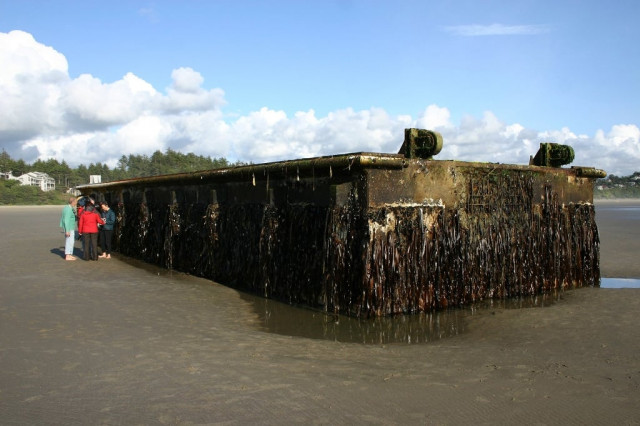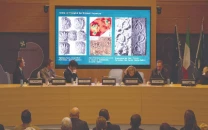US strips seaweed from Japanese tsunami wreck
Japan's 66-foot long tsunami-wrecked dock landed on a beach in Oregon.

The Oregon Department of Fish and Wildlife ordered the action after the 66-foot long concrete and metal structure, the biggest piece of tsunami debris to reach the US West Coast so far, landed on a beach in Oregon.
A dozen or so workers and volunteers used shovels, rakes and other tools to scrape the wreck clean, then briefly used low-pressure flame torches to sterilize the dock, said the Oregon Parks and Recreation Department (OPRD).
OPRD spokesman Chris Havel said the Japanese marine life clinging to it could harm the local environment.
"A species that evolves in an ecosystem evolves with natural checks and balance," Havel told AFP.
"When you take an organism out of the environment, and put it in a new environment, the balance is lost. It can outcompete the native species and animals," he added.
"You end up with the native ecosystem being kicked out and the unbalanced ecosystem taking its place."
The wrecked dock appeared off the coast on Monday, and washed up early Tuesday on Agate beach, near the town of Newport some 100 miles southwest of Portland.
Oregon officials contacted Japanese diplomats, who confirmed it was debris from the March 11, 2011 tsunami and had drifted 5,500 miles across the Pacific.
Japanese officials confirmed that the dock – 66 feet long, 19 feet wide and 7 feet tall – came from the port of Misawa, in Aomori prefecture in the northern part of Japan. A Japanese-language metal plaque was dated June 2008.
The wreck has been checked for radioactivity – the killer earthquake and tsunami triggered a disaster at the Fukushima nuclear plant on Japan's east coast – but proved negative, said the OPRD spokesman.
But the marine life still represented an environmental threat, he said.
"One of the organisms they identified is algae, it's a wakame. It looks like kelp. It's native to Japan, it's invaded Southern California. It's not currently present in Oregon," he said.
"Because of that and the possibility of other species that don't belong here, we've cleaned the entire surface of the dock. After they scraped it down, they hit it with a short burst of fire to sterilize it."
Various debris from the Japanese tsunami have begun washing up on the US and Canadian west coast, and experts predict a surge of flotsam in the coming months.
The OPRD spokesman said the dock was bigger than either a trawler scuttled off Alaska in April for safety reasons, or a shipping container with a Harley-Davidson inside that washed up on a Canadian beach at the start of May.
Havel added that it was impossible to estimate how much extra it will cost West Coast authorities to clean up debris caused by the Japanese tsunami.
Oregon's budget for coastal cleanup has been increased to prepare for the tsunami debris. This year the Oregon parks department has budgeted $135,000, he said.
But he warned: "No single agency's budget is prepared for many instances of this. No single agency is going to be able to put the money into it and call it good.
"This is not just an Oregon question, this is a Washington, California, Alaska question," he said, referring to other US West Coast states. "We can pay for this one instance," he added.
"What's not sure is where do we go from here."



















COMMENTS
Comments are moderated and generally will be posted if they are on-topic and not abusive.
For more information, please see our Comments FAQ